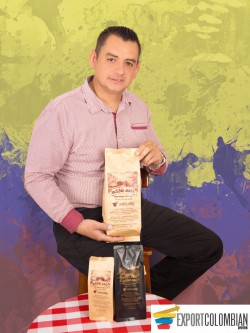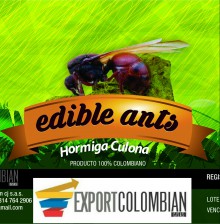 Interview with Vladimir Cardenas Galeano, Marketing Manager at Export Colombia
Interview with Vladimir Cardenas Galeano, Marketing Manager at Export Colombia
Tell us how you guys get involved in the edible insects world
500 years ago the edible ant is part of our gastronomy, a custom inherited from our indigenous ancestors. Since that time, every morning, for nine weeks a year, men stand guard at the mouths of anthill pits, thousands of them come out of the anthills at that time are trapped by peasants, in bags, jugs, to be toasted, the idea of marketing arises because one of the most typical products of our region “the Ant”, has been having an important growth In the national market, For this reason develop an innovative proposal that allows to show a new image for the perception of the consumer and that also contributes to the socioeconomic development of the country, Generating own benefits, of employees and the community.
What products are you marketing?
We are a company dedicated to edible ant, having as fundamental principles the honesty and responsibility towards the preservation of nature and towards our clients, governed by strict quality and service standards.
Why are you focused on ants?
The “Culona” ant is a part of our social and cultural heritage in the lands of Santander. The high protein content makes it a special food and their taste mekes them a delicacy during the harvest period from March to April. Ants are the caviar for the people living in Santanderea and they can be used in a variety of recipes.
Ants are a treasure whose value has been recognized by generations of Santandereans and goes back to an ancient tradition of the indigenous Guanes.
Do you need any special authorization to deal with edible insects in Colombia?
We need a standard legal authorization for the export and to market in Colombia.
Our company is also registered in INVIMA (registry of the National Institute for Surveillance of Drugs and Foods) taht is an technical-scientific surveillance and control institution that works for the protection of the individual and collective health of Colombians applying the sanitary-hygenic rules for the production and consumption of food.
Do you farm insects yourself?
Ants can not be farmed, the process is natural. Every year from April to June this curious little animal comes out of its anthills in the Santanderean mountains and is collected in a traditional way by the people of the region. The technique is based on basic strategies: in April torrential rains arrive in the region and that is the time the ants use for reproduction and migration. When the anthills are flooded, the ants come go out to dry themselves, to clean and find food supplies, The rain and the sun make the perfect combination when waiting for a harvest of ants.
We also collect “Culona” ants (that are the ants with wings) that can reach up to 2.5 cm.
Alternative foods as edible insects is a need or just the trend of the moment?
Entomophagy and insect-based food are not a new phenomenon. In addition to the archaeological evidence that indicates that this practice goes back to the earliest times, there are others more anthropological evidence of the importance that insects had in the diets of our ancestors.
I would say that they are a need that is being recognized in several parts of the world.





